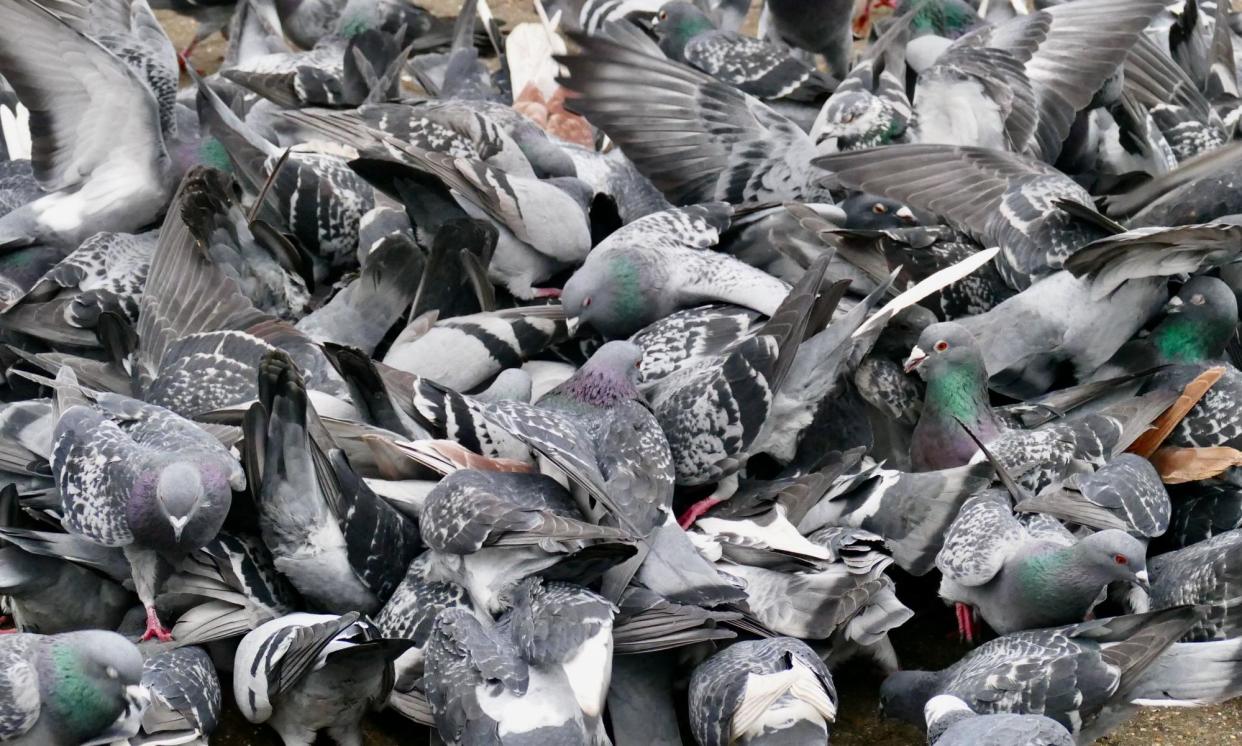How do you put pigeons on the pill? Scientists test contraceptives to curb pest numbers

The invention of the contraceptive pill heralded the sexual revolution of the 1960s, and now scientists are looking to revolutionise wildlife control by getting animals in on the action. Trials are under way in the UK and elsewhere in Europe of how to get contraceptives into pigeons, wild boar and grey squirrels, with scientists also proposingother rodents, invasive parakeets and deer as other target species.
As destruction from invasive and pest species grows, researchers are looking to fill special feeders and bait boxes with hazelnut spreads and grains laced with contraceptives. They believe this could be a more humane and effective way of controlling populations that have previously been poisoned, shot or trapped.
The aim is to find “creative solutions”, says Dr Giovanna Massei from York University: “The main message is that the economic and the environmental impact of wildlife are increasing worldwide, and we are running out of options.
“Traditional methods such as culling are ineffective, can be inhumane, unsustainable, environmentally harmful, and are increasingly opposed by the public,” she says.
Grey squirrels are a particular issue for the UK. These non-native animals were first introduced from the US to England in the 1800s as an ornamental species for stately homes. However, they spread widely, causing local extinctions of the native red squirrels and damaging woodlands by stripping bark.
The species is estimated to cost £37m a year in lost timber in England and Wales. Grey squirrels are seen as a bigger threat to broadleaf trees than deer and pathogens, according to a Royal Forestry Society survey.
Trials are under way to deliver oral contraceptives hidden in a hazelnut spread for squirrels in the UK, using specially weighted feeders that only grey squirrels can open (red squirrels are lighter, so the trap will not open for them). Preliminary results suggest the method is working.
Pigeons could be fed a “breakfast” of corn grains containing the contraceptive every morning, said Dr Marco Pellizzari, a veterinary consultant. “They really love to get that … It’s very easy,” he says.
In London, the non-native parakeet could also be a recipient, but it would mean asking residents who routinely feed them in their gardens to give them food with contraceptives in it.
We don’t have many alternatives to lethal control
Prof Steve Belmain
Next week York University will host the first workshop on wildlife fertility control, where experts and researchers involved in the trials will discuss how to deliver contraceptives to pests – animals considered harmful to people, farming or native habitats.
Across continental Europe and Scandinavia, there has been a rapid increase in wild boars, with the rise in numbers believed to be linked to milder winters. Some consider them pests because they root up cropland, munch through rubbish and cause traffic accidents. Italian farmers’ associations say the wild boar population doubled from 500,000 in 2010 to one million by 2020.
In Germany and in France, more than half a million are shot every year, but numbers are increasing, and the number of people who want to hunt them is declining. Massei says culling is “clearly not controlling a number of these animals”.
A pilot programme is under way to look at giving them contraceptives using devices that only boar can lift up, using their burrowing snouts. The feeder works but the oral contraceptive has not yet been developed.
Many countries are now banning the use of rodenticides because of their impact on other animals, including birds of prey, which have died from eating the poisoned carcasses.
The chemicals are also considered inhumane, as animals can suffer for several days after eating anticoagulants before they die. Glue traps have been banned in England, Scotland and Wales, and other sorts of live traps will probably be further regulated, according to Prof Steve Belmain, an ecologist from Greenwich University.
Yet rodents pose significant threats to agriculture, as well as transmitting diseases to livestock. “We don’t have many alternatives to lethal control. That’s where fertility control really could be a great opportunity to manage these things,” says Belmain.
Related: ‘Crabs everywhere’: off Canada’s Pacific coast, Indigenous Haida fight a host of invasive species
Feral horses in the US are already on contraceptives, as well as African elephants outside Kruger national park, who are injected. The only contraceptive registered for use in Europe is nicarbazin, which is only allowed to be used on pigeons in a few countries such as Italy, Spain, Belgium and Austria.
Researchers are also looking into the possibility of giving deer contraception, but so far no orally administered one has been designed for grazing animals. Britain has more deer than at any point in the past 1,000 years, causing extensive damage to woodlands.
There is concern that using products based on synthetic hormones could result in oestrogenic chemicals getting into the environment, which has negative effects such as feminising male fish. It is also not known what the impacts would be on a predatory bird if it ate a rodent that had eaten a contraceptive. “We need to really understand these things as part of that regulatory process,” says Belmain.

 Yahoo News
Yahoo News 
